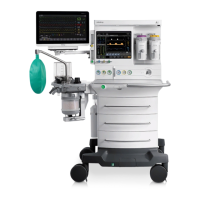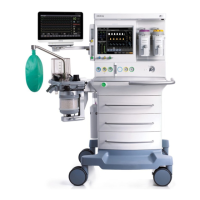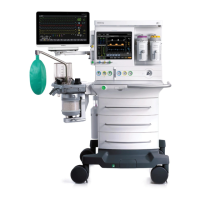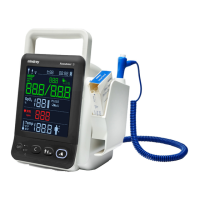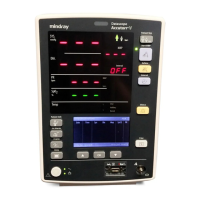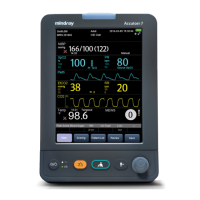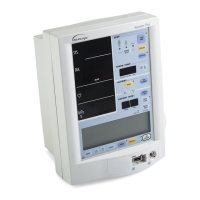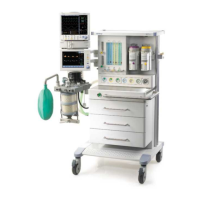7-67
7.6.5.1 FCS Tests
1. Properly connect the gas supply (O2, N2, and AIR), and let the machine enter the standby
state.
2. Select Setup > Service > Diagnostic Tests > FCS Tests to access the FCS diagnostic test
screen.
3. Set the BFCS two-way valve to EFCS and BFCS in turn. On the status bar on the left, the
BFCS two-way valve status should be consistent with the settings. Otherwise, the BFCS
two-way valve is faulty.
4. Set the O2 two-way valve to On and Off in turn. On the status bar on the left, the O2
two-way valve status should be consistent with the settings. Otherwise, the O2 two-way
valve is faulty.
5. Use the preceding method to test the N2O three-way valve and AIR three-way valve. If the
monitored status is inconsistent with the settings, the corresponding three-way valve is
faulty.
6. Before the current of the O2 proportional valve is set, the current of the O2 proportional
valve displayed on the status bar on the left should not be above 10 mA. Set the current of
the O2 proportional valve to 300 mA, the current of the O2 proportional valve displayed on
the status bar should fall within the range of 270-330 mA. Otherwise, the O2 proportional
valve is faulty.
7. Before the current of the balance gas proportional valve is set, the current of the balance gas
proportional valve displayed on the status bar on the left should not be above 10 mA. Set the
current of the balance gas proportional valve to 300 mA, the current of the balance gas
proportional valve displayed on the status bar should fall within the range of 270-330 mA.
Otherwise, the balance gas proportional valve is faulty.
8. Set the BFCS two-way valve to EFCS and O2 two-way valve to ON, and ensure that both
the N2O three-way valve and AIR three-way valve are in Off state. Set the current of the O2
proportional valve to 300 mA. The O2 limb flow and the total flow displayed on the left
should be above 0.
If both the O2 limb flow and the total flow are 0, the O2 two-way valve or the O2
proportional valve is faulty.
If only the reading on one flowmeter is above 0, and the reading on the other flowmeter is
the invalid value "---" or 0, the sensor that displays the invalid value or 0 is faulty.
Or, if the difference between the values of two sensors is greater than 10% or 0.2 L/min, a
sensor is faulty. In this case, perform step 9 to identify the faulty sensor.
9. Set the BFCS two-way valve to EFCS and AIR three-way valve to ON, and ensure that both
the O2 two-way valve and N2O three-way valve are in Off state. Set the current of the
balance gas proportional valve to 300 mA. The balance gas limb flow and the total flow
displayed on the left should be above 0.
If both the balance gas limb flow and the total flow are 0, the AIR three-way valve or the
balance gas proportional valve is faulty. If no flow is detected in step 10, the balance gas
proportional valve is faulty. Otherwise, the AIR three-way valve is faulty.
If only the reading on one flowmeter is above 0, and the reading on the other flowmeter is
the invalid value "---" or 0, the sensor that displays the invalid value or 0 is faulty.
Or, if the difference between the values of two sensors is greater than 10% or 0.2 L/min, a
sensor is faulty. Compare the result with that in step 8. If the total flow is relatively large or
small in both tests, the total flow sensor is faulty. Otherwise, the limb sensor is faulty.
10. Set the BFCS two-way valve to EFCS and N2O three-way valve to ON, and ensure that
both the O2 two-way valve and AIR three-way valve are in Off state. Set the current of the
